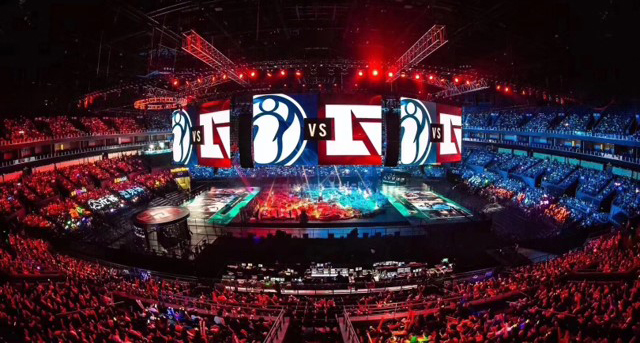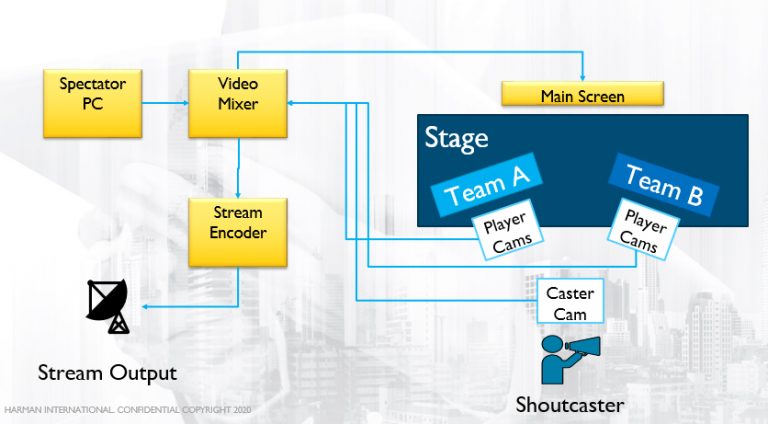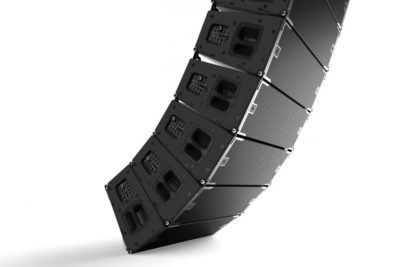Rightsizing Esports: AudioVideo Solutions For Your Event
Esports, a form of entertainment, featuring organized multiplayer video game competitions, is a quickly growing industry that’s only getting more popular each year.

While international finals are often mega-productions held in arenas of more than 60,000 attendees, esports events can range in size from high school-level matches and university competitions to the theatrical spectacles described above. Esports events come with their own set of unique requirements and challenges to consider when designing an appropriate AV system in order to support the action and deliver a dynamic fan experience. In this blog, we will examine the basic technical structure of esports applications and how to use that framework to build AV systems for small-scale local events, regional finals, university-level galas, and international championships.
Types of Esports
It’s important to consider what type of game is being played at each event, as each genre has its own set of technical requirements. There are four main types of esports games, which pose increasing degrees of complexity when it comes to preparing the AV system:
- Sports Simulators
- First-Person Shooters
- Real-Time Strategy
- Battle Royale
Sports Simulators
This category includes games that simulate real-life sports like soccer, football, basketball, baseball, hockey and boxing, but we also include fighting games like Street Fighter and Tekken in this category. Matches can range from two individual players to two teams with three to five players each. This type of game is usually the simplest, from an AV perspective, because all of the players see the same screen. Because of this, there’s no reason to keep players from being able to see what’s happening on other players’ screens, and they can be grouped closer together.
First-Person Shooters
The second category consists of first-person shooters like Call of Duty, Counterstrike (CS:GO), and Overwatch. These games are characterized by high-speed action with each player having their own unique point-of-view. The main challenge with first-person shooters is that you can’t see the whole map at one time. Another challenge is that the speed of gameplay combined with the first-person perspective has the potential to cause motion-sickness for audiences watching.
In order to give the audience the best viewing experience, the best method is taking a video feed from “ghost players” that run a spectator mode of the game. They have the freedom to move, fly and zoom around the map but are invisible to the players and can’t interfere in the action. These players function as phantom camerapersons. Keeping out of your competitor’s view is a main tactic, so teams need to be isolated so that they can’t see the other teams’ screens or the main video screen.
Real-Time Strategy
In this genre, players control multiple characters from a top-down view. These games usually simulate the strategies of commanding generals at war with an enemy force. Each individual player has a field of view that is limited by a “fog of war,” meaning the player can only see areas they’ve explored, and can’t necessarily see the enemy’s territories. By contrast, the viewing audience needs to be able to see the whole map or arena. Again, this requires a spectator player to provide a complete video feed of the entire map.
Battle Royale
The final category of esports games is one of the newest genres being played. Battle royale games have exploded in popularity in the past few years, with popular titles like Fortnite and Apex Legends, leading the market. These games host up to 100 players in the same arena, with the simple goal of being the last player standing. From a technical standpoint, these games are similar to first-person shooters, but with a third-person perspective. Another difference is that the majority of players are gaming on mobile devices, so accommodating this type of input is crucial.
Two Audiences
A typical esports event will have two audiences: a live in-person audience and a streaming audience, tuned into the broadcast from home. Each audience has its own set of priorities, and the needs of both must be considered when designing an event. For example, the live audience wants an immersive audio experience, with the same intensity as a rock concert. Meanwhile, the broadcast audience needs clarity to clearly understand the commentary. On the visual side of things, the broadcast team needs bright, clear lighting for their cameras to operate properly, but the live audience wants an engaging light show with rich colors and dazzling effects.
Audio Systems for Esports
Traditional audio matrices are typically single-unit devices that can be connected by a proprietary format and include transport between various areas of the event space. The downside of the traditional matrix is that it’s usually limited to a certain number of inputs and outputs, and if you exceed that, you’ll need to buy an additional device. Fortunately, the ubiquity of Audio-Over-IP (AoIP) standards such as Dante or AES67 now makes it possible to distribute any number of audio inputs and outputs over a network. Network matrices are only limited by the bandwidth of the network itself.
Utilizing a network audio matrix, we can receive the audio signals from a high number of sources, including player devices and team intercoms, as well as microphones for the players, judges, coaches, and shoutcasters. We can then transmit them to the front of house mixer, broadcast mixer and player intercom systems, as well as route them through signal processors and networked amplifiers.

From an audio perspective, we need to be able to mix a variety of sources (player intercoms, in-game audio, judges, coaches, and shoutcasters) and deliver separate audio feeds for the live audience, broadcast audience, and possibly to the athletes themselves. In order to accomplish this, we need to utilize an audio matrix. An audio matrix enables any input to be routed to any output or multiple outputs, and many matrices support mixing as well, simplifying the workload of the live and broadcast audio engineers.
Lighting Systems for Esports
Lighting also needs to be approached carefully at esports events, because the goal is to simultaneously deliver high-quality visual experiences to the live and broadcast audiences. Lighting fixtures used in esports, generally fall into four categories:
Broadcast Fixtures – Dynamic light is great for live audiences but causes problems on camera. The camera operators will need sources of natural white light in order to capture the action of the players. These fixtures are placed close to the stage or player areas.
Front-Of-House Fixtures – Natural white light is great for cameras but looks flat and boring to live audiences. Interesting and dynamic wash lighting creates a dramatic mood for the audience. These fixtures are placed farther away from the stage.
Effects Fixtures – Automatable moving-head fixtures can create an exciting spectacle in the arena, ensuring a satisfying live entertainment experience for the audience.
LED Walls – High-resolution video walls are required so that audiences can see the action. Intelligent hybrid LED fixtures can also accept video inputs and create appropriate lighting content to match the action onscreen. Colors can also be used to signify different stages of gameplay—for example, red lights may mean that a bomb has been set in-game.
Video Systems for Esports

Just as we discussed with the audio systems, we need to design the video system to accommodate the differing requirements for the live and broadcast audiences. The live audience may only need to see the gameplay on screen, with occasional camera close-ups, while the broadcast audience will likely need a combination of gameplay and camera footage of the players, shoutcasters, and audience.
In order to show the gameplay to the audiences, we utilize dedicated spectator devices to provide the video feeds. This ensures more control over what the audience can see, with the added benefit of keeping lag, associated with video-interfacing out of the player equations.
Rightsizing Your Esports Event
Not all esports events are created equal, and an AV system utilized at one event may not be appropriate for another event on a different scale. If you’re tasked with handling the AV for an esports event, this section will show you the essential equipment you’ll need to produce quality experiences for your audiences.
For small or mid-sized high school or university-level competitions with a limited in-person audience, you’ll need:
- Player Intercoms – These enable teammates to communicate with one another during a match.
- Gaming Headsets – These allow the gamers to hear the game audio with zero latency.
- Spectator Device – This is a separate device installed with spectator versions of the games being played.
- Streaming Software – This is an application that handles simple video mixing tasks and stream encoding, such as: Streamlabs OBS, OBS Studio (Open Broadcaster Software), vMix Free
- Lighting – Standard venue lighting is more than adequate for events at this level.
- Audio – A small digital mixer can handle audio feeds for people in the room and the streaming audience. Portable JBL EON powered speakers will cover a medium-sized room with no trouble.

For large events with audiences of more than 300 people, consider adding the following:
- Matrix Intercoms – Reidel and Clearcom make dedicated communication systems for failsafe operation.
- Spectator Device – Many games offer a Tournament Mode version for higher-profile events.
- Streaming Video Mixer – OBS or vMix Free may not cut it at this level. vMix 4K offers recording capabilities and higher resolution for graphics.
- Live Video Mixer – For audiences of this size, a Ross Graphite hardware mixer gives greater control over more video input and output options. A projector and large screen are also required to display the video signal.
- Lighting – In addition to standard venue lighting, include natural white light for cameras and moving lights for dynamic effects.
Audio – You may want to consider upgrading the portable powered speakers to JBL VTX line arrays or other larger PA systems, similar to those found at concerts.
Image & Content Credits: https://pro.harman.com/insights/enterprise/rightsizing-esports-solutions-from-schools-to-stadia/




